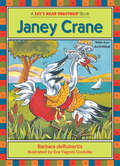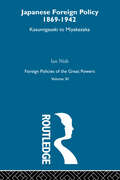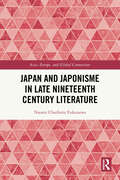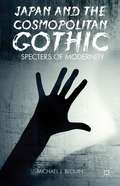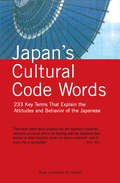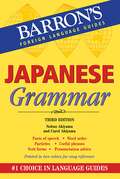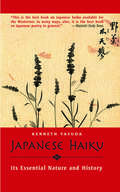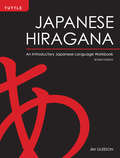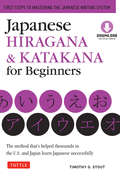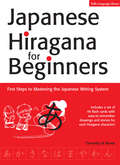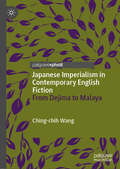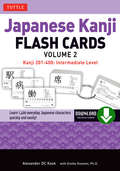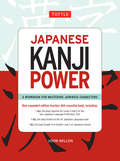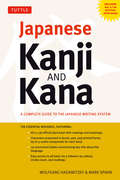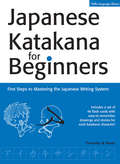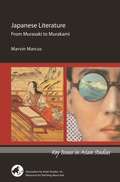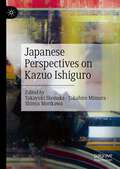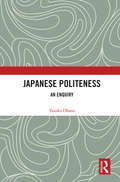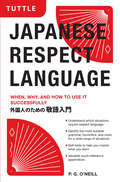- Table View
- List View
Janey Crane: Long Vowel A (Let's Read Together ®)
by Barbara deRubertisLet&’s Read Together books merge rhyme and vowel sounds in delightfully zany stories kids will want to read again and again. Each of the 15 books in this classic series by award-winning author/educator Barbara deRubertis will give your child a jumpstart on reading success."Story lines are silly and inventive, and recall Dr. Seuss&’s Cat in the Hat for the building of rhythm and rhyming words." —School Library JournalJaney Crane bakes three tasty cakes for her friends, but there's more than one surprise in store for Janey! (This easy-to-read story features the long &“a&” vowel sound.)
Jap Foreign Pol 1869-1942 V11: Kasumigaseki To Miyakezaka
by NishFirst published in 2001. Routledge is an imprint of Taylor & Francis, an informa company.
Japan and Japonisme in Late Nineteenth Century Literature (Asia, Europe, and Global Connections)
by Naomi Charlotte FukuzawaThis book examines the transnational phenomenon of Japonisme in the exoticist and “autoexoticist” literature of the late nineteenth century.Focusing on the way in which reciprocal processes of transcultural acquisition – by Japan and from Japan – were portrayed in the medium of literature, the book illustrates how literary Japonisme and the wider processes whereby Japan, with its alien exotic culture and unique refined aestheticism, was absorbing Western civilization in its own way in the late nineteenth century at the same time as the phenomenon of Japonisme was occurring in Western fine arts, which were inspired by traditional Japanese artistic practices. Specifically, the book focuses on the literary works of Lafcadio Hearn and Pierre Loti, who travelled from France and America, respectively, to Japan, and Mori Ōgai and Natsume Sōseki, who in turn went, respectively, to Germany and England from Japan.Exploring the eclectic hybridity of Japan’s modernization during the late nineteenth century, this book will appeal to students and scholars of Japanese Studies, Postcolonial Studies and Comparative Literature.
Japan and the Cosmopolitan Gothic
by Michael J. BlouinJapan is imagined routinely in American discourse as a supernatural entity. Gothic tales from these two cultures have been exchanged, consumed, and adapted. Here, Blouin examines a prevalent tendency within the United States-Japan cultural relationship to project anxiety outward only to find shadowy outlines of the self abroad.
Japan's Cultural Code Words: Key Terms That Explain the Attitudes and Behavior of the Japanese
by Boye Lafayette De MenteThis book is a study of Japanese society through the understanding of the key terms and concepts that define their attitudes and behaviors. <p><p> Westerners have traditionally been intrigued by Japanese attitudes and behaviors which have been perceived as ranging from cute, quaint, and seductive to strange and sometimes savage. The traditional dual character of the Japanese is generally attributed to cultural conditioning-strict conformity to standards set by the ruling powers and to sanctified custom-at the expense of individuality and personal freedom. Since World War II, the traditional conditioning and orientation of the Japanese has diminished and continuing influence from the West has wrought fundamental changes in the attitudes and behavior of the Japanese. Nevertheless, Japan's traditional culture is still so powerful that it continues to be the prevailing force in molding and tuning the national character of the Japanese, with the result that they still have two faces-one modern and rational, the other traditional and emotional.
Japanese Counterculture: The Antiestablishment Art of Terayama Shuji
by Steven C. RidgelyTerayama Shuji (1935-1983) was an avant-garde Japanese poet, dramatist, film director, and photographer known for his highly provocative work. In this inventive and revealing work, Steven Ridgely examines Terayama's life and art to show that a conventional notion of him does not do full justice to the meaning and importance of his wide-ranging, often playful body of work.Ridgely places Terayama at the center of Japanese and global counterculture and finds in his work a larger story about the history of postwar Japanese art and culture. He sees Terayama as reflecting the most significant events of his day: young poets seizing control of haiku and tanka in the 1950s, radio drama experimenting with form and content after the cultural shift to television around 1960, young assistant directors given free rein in the New Wave as cinema combated television, underground theatre in the politicized late 1960s, and experimental short film through the 1970s after both the studio system and art house cinema had collapsed.Featuring close readings of Terayama's art, Ridgely demonstrates how across his oeuvre there are patterns that sidestep existing power structures, never offering direct opposition but nevertheless making the opposition plain. And, he claims, there is always in Terayama's work a broad call for seeking out or creating pockets of fiction-where we are made aware that things are not what they seem-and to use otherness in those spaces to take a clearer view of reality.
Japanese Grammar (Barron's Grammar Ser.)
by Nobuo Akiyama Carol AkiyamaA Simon & Schuster eBook. Simon & Schuster has a great book for every reader.
Japanese Haiku
by Kenneth YasudaThis is the most authoritative and concise book on Japanese haiku available: what it is, how it developed, and how it is practiced in both Japanese and English. While many haiku collections are available to Western readers, few books combine both translated haiku with haiku written originally in English, along with an analysis of individual poems and of the haiku form itself. Written by a leading scholar in the field--Kenneth Yasuda was the first American to receive a doctorate in Japanese literature from Tokyo University--Japanese Haiku has been widely acclaimed. This edition is completely repackaged for 2002, and is the perfect book for lovers of poetry who do not have a solid background in haiku.
Japanese Hiragana
by Jim GleesonThis workbook has been carefully designed to facilitate the quick and easy mastery of the forty-six character hiragana syllabary used to write all types of native words not written in kanji.Each character is introduced here with brushed, handwritten, and typed samples to enhance character recognition. Entertaining illustrations and amusing examples of onomatopoeic usage of hiragana in Japanese writings further reinforce memorization in a fun way.This easy-to-use and practical workbook is well suited for beginning students of all ages. This revised edition has 16 more pages of exercises and additional practice pages.
Japanese Hiragana
by Jim GleesonThis workbook has been carefully designed to facilitate the quick and easy mastery of the forty-six character hiragana syllabary used to write all types of native words not written in kanji.Each character is introduced here with brushed, handwritten, and typed samples to enhance character recognition. Entertaining illustrations and amusing examples of onomatopoeic usage of hiragana in Japanese writings further reinforce memorization in a fun way.This easy-to-use and practical workbook is well suited for beginning students of all ages. This revised edition has 16 more pages of exercises and additional practice pages.
Japanese Hiragana & Katakana for Beginners
by Timothy G. StoutThe method that's helped thousands in the U.S. and Japan learn Japanese successfully.Japanese has two basic writing systems, hiragana and katakana, in addition to the one that uses Chinese characters or Kanji. <P><P> This handy book teaches you a new mnemonics-based method to read and write the basic 92 hiragana and katakana characters.Memorable picture mnemonics help you to learn the characters by associating their shapes and sounds with combinations of images and English words already familiar to you.Clear examples and entertaining exercises offer opportunities to read, write, use and practice all 46 basic hiragana and 46 basic katakana characters, plus the remaining kana that stand for more complex sounds.Polish your knowledge with word searches, crossword puzzles, fill-in-the-blanks, timed recognition quizzes, and other interesting activities.The Downloadable Content allows you to print out your own flash cards (featuring the same mnemonic images taught in the book) to help you review and practice, even while you're on the go.
Japanese Hiragana for Beginners: First Steps to Mastering the Japanese Writing System
by Timothy G. StoutLearn how to write all the basic Japanese hiragana with this user-friendly workbook.<P><P>Japanese Hiragana for Beginners makes learning hiragana fast and effective by using memorable picture mnemonics, along with clear explanations, examples and lots of fun exercises-a method that has helped thousands of students learn hiragana successfully in the United States and Japan. Picture mnemonics enhance memory by associating the shape and sound of each hiragana character with combinations of images and English words already familiar to students.This Japanese language learning book is divided into three main sections: Section 1 introduces the basic 46 hiragana characters along with writing tips and practice exercises. Section 2 teaches the usage rules that allow students to write Japanese sounds. Section 3 strengthens students' skills through a wide range of exercises (word searches, crossword puzzles, fill in the blanks, visual discrimination, timed quizzes, etc).A set of flash cards printed on perforated cardstock and a list of suggested flash card activities, are also provided at the end of the book. Each of these cards introduces a hiragana character along with picture mnemonic that helps to recognize and remember it.
Japanese Imperialism in Contemporary English Fiction: From Dejima to Malaya
by Ching-chih WangThis book considers literary images of Japan created by David Mitchell, Kazuo Ishiguro, and Tan Twan Eng to examine the influence of Japanese imperialism and its legacy at a time when culture was appropriated as route to governmentality and violence justified as root to peace. Using David Mitchell’s The Thousand Autumns of Jacob de Zoet, Tan Twang Eng’s The Garden of the Evening Mists and Kazuo Ishiguro’s work to examine Japanese militarists’ tactics of usurpation and how Japanese imperialism reached out to the grass-root public and turned into a fundamental belief in colonial invasion and imperial expansion, the book provides an in depth study of trauma, memory and war. From studying the rise of Japanese imperialism to Japan’s legitimization of colonial invasion, in addition to the devastating consequences of imperialism on both the colonizers and the colonized, the book provides a literary, discursive context to re-examine the forces of civilization which will appeal to all those interested in diasporic literature and postcolonial discourse, and the continued relevance of literature in understanding memory, legacy and war.
Japanese Kanji Flash Cards Volume 2: Intermediate Level (Downloadable Material Included)
by Emiko Konomi Alexander KaskEverything you need to learn 200 everyday Japanese kanji characters is here in this ebook!Flash cards are an essential tool in memorizing words when you are learning a new language. In Japanese Kanji Flash Cards Kit, Volume 2, you'll get all the tools needed to learn 200 everyday Japanese kanji, following on from the 200 kanji introduced in Volume 1 of this series.This Japanese language ebook includes: 200 flash cards featuring commonly used characters. Downloadable audio recordings of over 1,200 words and phrases from a native speaker. A 32-page study booklet with sorting indexes and practice tips. Each expertly designed flash card in this ebook offers core information about the meanings, pronunciations, vocabulary, and usage for each character along with memorable phrases and drawings to help you learn the kanji. A stroke-order diagram shows how to write the kanji correctly. You can also sort the cards into smaller sets so you can learn or review them in batches and help to remember the kanji character effectively.
Japanese Kanji Power
by John MillenJapanese Kanji Power is a workbook for mastering Japanese characters (Kanji) with the added power of a dictionary.This resource is essential for the serious student looking to get an A in Kanji class or the language enthusiast ready to take written Japanese to the next level. This new expanded edition teaches all 464 essential Kanji required for Levels 4 and 5 of the new Japanese Language Proficiency Test and the AP Japanese Language exam. Each Kanji is presented with the information needed to learn and remember the character and its many variations and uses. Cumulative exercises allow students to practice the Kanji and strengthen existing knowledge. An indexing feature allows Japanese Kanji Power to function as a Kanji dictionary.The presentation of each Kanji incorporates a number of key features, including:Several example sentences that introduce each kanji reading in contextA list of frequently-used compounds and phrases that allows you to increase your practical vocabularyBackground information, such as the original of the character of a mnemonic to aid in memorizationStroke count and a stroke-order diagramWriting hints and a writing practice gridNumerous exercises and frequent reviews for reinforcement
Japanese Kanji and Kana
by Mark Spahn Wolfgang HadamitzkyThis is a self-study book for leaning Japanese Kanji and KanaLong the leading book for learning Japanese Characters, Japanese Kanji and Kana is the resource you need to master the basic Japanese characters (kanji) and the hiragana and katakana syllabaries (known collectively as kana).Complete, compact and essential, this is the resource you need in order to use and master kanji. This new edition reflects the recent update by the Japanese government of the official Joyo kanji list. Joyo means "daily use," and these 2,136 kanji are the ones that every Japanese person learns in public education. The kana and kanji are presented in an easy to understand format. A concise indexing section also allows the book to function as a Japanese dictionary and plenty of extra space is allowed for writing Kanji and writing Kana. All the characters are written clearly making reading kanji and reading kana effortless.This book features:All 2,136 official Joyo kanji with readings and meaningsUp to 5 useful compounds for each kanjiBrush & pen forms, too-not only printed form19 convenient tables summarizing key info about the languageEasy access to all kanji via 3 indexes: by radical, stroke count, and readings
Japanese Kanji and Kana
by Mark Spahn Wolfgang HadamitzkyThis comprehensive book helps you learn the 92 basic Kana characters and 2,136 standard Kanji characters.Complete, compact and authoritative--this book provides all the information needed to learn the Japanese writing system, including the 92 basic hiragana and katakana phonetic symbols (known collectively as Kana) and the 2,136 standard Joyo Kanji characters that every Japanese person learns in school.The kana and kanji are presented in an easy and systematic way that helps you learn them quickly and retain what you have learned and improve your mastery of the Japanese language--the ability to read Japanese and write Japanese is an essential skill for any student. A concise index allows you to look up the Kanji in three different ways (so the book also serves as a Japanese Kanji dictionary) and extra spaces are provided to allow you to practice writing Japanese. This book contains: All 2,136 official Joyo kanji with readings and definitions. Characters are graded by their JLPT examination levels. Up to 5 useful vocabulary compounds for each kanji. Brush and pen cursive forms as well as printed forms. 19 tables summarizing key information about the characters. Kanji look-up indexes by radicals, stroke counts and readings.
Japanese Kanji and Kana
by Mark Spahn Wolfgang HadamitzkyThis comprehensive book helps you learn the 92 basic Kana characters and 2,136 standard Kanji characters.Complete, compact and authoritative-this book provides all the information needed to learn kanji and kana, including the 92 basic hiragana and katakana phonetic symbols (known collectively as Kana) and the 2,136 standard Joyo Kanji characters that every Japanese person learns in school.The kana and kanji are presented in an easy and systematic way that helps you learn them quickly and retain what you have learned and improve your mastery of the Japanese language-the ability to read Japanese and write Japanese is an essential skill for any student. A concise index allows you to look up the Kanji in three different ways (so the book also serves as a Japanese Kanji dictionary) and extra spaces are provided to allow you to practice writing Japanese. This book contains: All 2,136 official Joyo kanji with readings and definitions. Characters are graded by their JLPT examination levels. Up to 5 useful vocabulary compounds for each kanji. Brush and pen cursive forms as well as printed forms. 19 tables summarizing key information about the characters. Kanji look-up indexes by radicals, stroke counts and readings.
Japanese Katakana for Beginners First Steps to Mastering the Japanese Writing System (Tuttle Language Library)
by Timothy G. StoutThis is a user-friendly guide to learning Japanese Katakana and includes a set of 46 flash cardsJapanese Katakana for Beginners makes learning of katakana fast and effective by using memorable picture mnemonics, along with clear explanations, examples and lots of fun exercises, a method that has helped thousands of students lean katakana successfully in the United States and Japan. <P><P>Picture mnemonics enhance memory by associating the shape and sound f each katakana character with combinations of images and English words already familiar to students. This book is organized into three main sections:The first introduces the basic 46 katakana characters along with writing tips and opportunities to practice writing them.The secondteachers the usage rules that allow students to write all Japanese sounds, providing more opportunities for practice.The third strengthens students' skills through a wide range of exercises (word searches, crossword puzzles, fill in the blanks, visual discrimination, timed recognition quizzes, etc) designed to both increase the knowledge of the Japanese language and reinforce newly acquired writing skillsA set of flash cards printed on perforated cardstock and a list of suggested flash card activities, are also provided at the end of the book. Each of these cards introduces a katakana character along with the picture mnemonic that helps to recognize and remember it.
Japanese Literature: From Murasaki To Murakami (Key Issues In Asian Studies)
by Marvin MarcusJapanese Literature: From Murasaki to Murakami provides a concise introduction to the literature of Japan that traces its origins in the seventh century and explores a literary legacy—and its cultural contexts—marked by the intersection of aristocratic elegance and warrior austerity. Coverage extends to the present day with a focus on the complex twists and turns that mark Japan’s literature in the modern period. In under one-hundred pages of narrative, Marcus’s account of Japanese literature ranges from the 712 CE publication of Japan’s first literary work, the Kojiki, to internationally-famous 21st century authors. Readers get a sense of past and contemporary literary themes and well written vignettes of the men and women who produced works that are an integral part of Japan’s literary traditions. Readers are introduced to Japanese literature, but Marcus’s linkages to history and culture increase the likelihood that many readers will be inspired to learn more about Japan and its rich history. Marcus’s compelling interpretations of significant works of Japanese literature and their historical moments complement carefully selected passages of literary prose, poetry, and images from Japan's long literary and cultural history. This small gem of a book is essential for students, teachers, and general audiences interested in Japan and its long literary traditions.
Japanese Perspectives on Kazuo Ishiguro
by Takayuki Shonaka Takahiro Mimura Shinya MorikawaThis collection of essays offers new perspectives from Japan on Nobel Prize–winning author Kazuo Ishiguro. It analyses the Japanese-born British author from the vantage point of his birthplace, showing how Ishiguro remains greatly indebted to Japanese culture and sensibilities. The influence of Japanese literature and film is evident in Ishiguro’s early novels as he deals with the problem of the atomic bomb and Japan’s war responsibility, yet his later works also engage with folk tales and the modern popular culture of Japan. The chapters consider a range of Japanese influences on Ishiguro and adaptations of Ishiguro’s work, including literary, cinematic and animated representations. The book makes use of newly archived drafts of Ishiguro’s manuscripts at the Harry Ransom Center at the University of Texas to explore the origins of his oeuvre. It also offers sharp, new examinations of Ishiguro’s work in relation to memory studies, especially in relation to Japan.
Japanese Politeness: An Enquiry
by Yasuko ObanaAlthough Japanese language is one of the most quoted examples in politeness research, extant publications focus on particular areas of politeness, and very few of them enquire into varied aspects of Japanese politeness. In this book, Yasuko Obana provides an integrated account of what signifies Japanese politeness. By examining how far previous assumptions can apply to Japanese, Obana exposes a variety of characteristics of Japanese politeness. By taking a diachronic approach, she probes into what constitutes politeness, extracts key elements of the term ‘polite’ in Japanese, and demonstrates how modern honorifics’ apparent diverse, divergent uses and effects can be integrated into a systematic matrix. Furthermore, by quoting traditional Japanese language scholars’ (kokugo gakusha) studies, Obana brings different views into the open. She also carves out politeness strategies in Japanese that have not been adequately explored to date. They often conform to the way in which honorifics behave because they often reflect social indexicality. This book is a good reference for scholars in pragmatics, particularly for those who are working on politeness. It is useful for Japanese language teachers who want to know how to teach Japanese politeness to non-native learners. Postgraduate students of Japanese or pragmatics will also find this book useful as a self-study book.
Japanese Respect Language: When, Why, and How to use it Successfully
by P. G. O'NeillRespect language—the special style of polite spoken or written Japanese—is involved almost every exchange of Japanese between one person and another, including the simplest phrases of greeting.<P><P> An understanding of its forms is therefore essential to any serious student of the Japanese language. This programmed course is carefully designed to teach the basic and correct forms which the learner should master for his or her own use, by first looking at the various typical situations to see when respect should and should not be shown in Japanese, and then going on to see how respect is expressed in special forms of speech. In this way the learner is shown how to identify the type of respect for used, the person to whom respect is being shown, and the equivalent form in colloquial language. The insights into both Japanese culture and language will help any student or businessperson traveling to Japan or speaking Japanese on a regular basis.
Japanese Science Fiction: A View of a Changing Society (Nissan Institute/Routledge Japanese Studies)
by Robert MatthewAfter the Meiji Restoration of 1868 Japan modernized rapidly, transforming itself perhaps more quickly than any other country in history. However, the change was not without its conflicts, many of them still unresolved as the pleasures of modern society vie with a respect for the traditional Japanese lifestyle. As the literature of change and of the young, science fiction acts as a window to the modern mind and the uneasy alliance of the old and new. This book, filled with detailed reference to numerous stories, traces the origin and development of the genre from the mid-nineteenth century to today, thus exploring unique insights into Japanese attitudes to commercialism, spirituality, the media, war and international relations.

